Direction: Sanjay Leela Bhansali
Cast: Deepika Padukone, Ranveer Singh, Shahid Kapoor
Rating – ***
Every time Sanjay Leela Bhansali comes up with a film, I rush to the theatres with great anticipation. Credit goes to his enthralling trailers. And yet, each time, I end up with disappointment. It all began in 1999, the year Hum Dil De Chuke Sanam released. Bhansali shed his realistic style of film-making (Khamoshi) and took up a strange, lyrical method of story-telling instead. Now his movies became larger than life with slow, indulgent scenes of romance and drama. The sets and costumes became overtly grand, sometimes distracting the viewer from the plot itself. The screenplay became stretched to such an extent, that towards the end of every film of his, the viewers wished the movie to somehow end. Only brilliant music and jaw-dropping visuals remained the two most consistently positive elements in his works. Padmaavat is no exception.
*** Spoiler Alert ***
The movie begins in 13th Century Afghanistan, dusty and forbidding. Inside a fort-like enclave, a clan of Muslim warriors are sitting in a circle and discussing about their chief. The said aging leader Jalaluddin Khalji (Raza Murad), his beefy form languid, is musing on his unfulfilled dream of conquering the prosperous Delhi Sultanate. During this chatter, suddenly the gate to the fort flings open. In walks a handsome, young man, his long hair, chiseled features, and sharp eyes exuding both menace and sex appeal. The old man pleased with the young intruder gives his daughter Mehrunissa’s hand to him. This youth is his nephew – Alauddin Khalji (Ranveer Singh).
The special day arrives. Everyone is decked, awaiting the grand wedding, but the groom is missing. When he finally shows up, he’s drunk and unperturbed. Shortly after, the guests start whispering. The reason behind his late arrival to the ceremony is discovered and Mehrunissa is informed. Shocked and terrified, she watches her new husband, as though for the first time, dancing under the moonlight – a satyr, a devil in a human body.
Far away from the dusty plains of Afghanistan, and unknown to the vicious Alauddin, lies the ethereal, green kingdom of Singhal. But even more beautiful than the serene, natural beauty is its princess, the strong, yet lovely, Padmavati (Deepika Padukone). King Rawal Ratan Singh (Shahid Kapoor) of Mewaar visits Singhal in search of rare pearls for his first wife. But in the process, he gets shot by the arrow of love (literally) and ends up meeting the lovely maiden. After a couple of tender moments, Ratan marries the princess and takes her with him to his kingdom: the celebrated Chittor in Mewar. And thus, the saga of Rani Padmavati begins.
Fast forward 30 minutes. Alauddin Khilji, the new Sultan of Delhi Sultanate hears about Padmavati from a banished sinner of Chittor. Mesmerized by the description of her beauty, intelligence and valour, he sets his mind on capturing her. With an army of thousands, he marches to Chittor through the desert, startling the unsuspecting Rajputs. Rawal pleads for help from the other kings of Rajputana, but they refuse to come to his aid. Some more melodrama follows. At last, the final battle begins between Rajput aan, baan, aur shaan and the Muslim “devilry,” where the latter eventually triumphs. The women of Chittor jump into fire, committing the controversial jauhar, and that, in short, is the crux of Padmaavat.
The movie was initially named as Padmaavati, which was then changed to Padmaavat owing to protests. It is difficult to tell what difference the extra “i”(or the lack of it) made but it surely allowed Bhansali to push all credits (and blames) to Malik Muhammad Jayasi’s 1540 poem Padmaavat for all liberties he took – something, which is cleared off in the form of disclaimer right at the very beginning.
Strangely enough, despite the title, the movie has very little scope for the legendary Queen herself. Most of the screen space is given to Ranveer Singh, who sings, dances, lusts, eats and kills through his way till the end. As Ranveer effortlessly gets inside the skin of the vicious ruler, Karni Sena’s unsaid fear comes out in the open.

When a lecherous villain is played by a heartthrob, hero-material actor like Ranveer Singh, doesn’t the said villain become somewhat likeable to the audience, and in a way, outshine the hero in this anti-hero loving era? Yes, he does.
On the flip side, how authentic is the portrayal of Khilji in the movie? He was no “Akbar the Great” for sure, but was the real Khilji indeed as demonic as depicted here? A perverted, barbaric, lunatic with no sense of honour, humanity, or polite behavior ? Or was the portrayal the result of the pressure on Bhansali’s shoulders to make Khilji as black as possible?
Blatant distortion of history and canon text has always been the modus operandi of Bollywood, which has championed the art of polarizing characters into black and white. Black Khalji. White Ratan Singh. And this time, it comes with a disclaimer (read legal consent for creativity), too. So I guess we’d have to leave it at that. Despite the demonisation, the eccentric Ranveer’s Khilji practically owns the film. And the Sultan is not the only scene-stealer.
 Image Source ->
Image Source ->
There’s a scene where Khilji’s wife Mehrunissa compliments Padmaavati – “I have never seen such a beauty before!” Though Bhansali tries hard, he fails to convince the viewers as Aditi Rao Hydari’s Mehrunissa looks far more appealing than Deepika’s over-decked Padmaavati. Her face looks ethereal in every shot, her eyes flowing with the palpable pain. Since Bhansali’s current muse Deepika Padukone was slated to play the titular role, Mehrunissa should have gone to – may I say – a less attractive (but not less talented) actress than Aditi. Add to that her crisp Urdu diction, Aditi manages to make her presence felt despite the negligible screen space.
Equally underrated is Shahid’s portrayal of the proud and noble Raja Rawal Ratan Singh. The actor is terrific. Raja Rawal Ratan Singh, on the other hand, not so much. In the quest to depict Rajput flawlessness, Bhansali has carved out an impractical, foolish king out of Ratan. His wife Padmavati and ministers come across as far more pragmatic than the unwise, imprudent ruler of Mewar. Also, the constant reminder of Rajput Aan Ban and Shaan becomes literally cringe-worthy and evidently forced after a point. The pressure to appease is evident.
Deepika looks stunning, no doubt, and nails every scene, especially the ending. Her eyes, swimming with tears, say a thousand words, making me wish she had more screen time. Another terrific performer is Jim Sarbh as Malik Kafur. Some might find his acting awkward, on account of the effeminate touch and “phoren-like” Hindi accent. But I believe that is precisely what Bhansali intended the man to be – the creepy, loyal, homosexual(?) partner of Khilji. The real Kafur in history, however, was much more than that. But okay, disclaimer.
That brings me to the last point – the controversial Jauhar.

As much I would like to scream out that the whole concept of Jauhar or Sati (though they are not the same) does have misogynistic undertones, and Swara Bhaskar isn’t entirely wrong, it would be sheer ignorance to judge the 14th Century custom through 21st Century feminist lenses.
Medieval India was a different world altogether. In a society where women had little freedom, were entirely dependent on their fathers, brothers, husbands, and sons, and most of all – were the most vulnerable to physical and sexual assault if captured by the enemy – a custom like Jauhar cannot be called “misogynistic” with 21st Century feminist sensibilities. Everything needs to be seen within its context, and thus it would be unfair to blame Bhansali for making a movie on this theme.
I am, however, disappointed less by Swara’s immaturity and more by the treatment of the scene itself. Mistake me not. The Jauhar itself is visually stunning, beautifully shot with heart-wrenching music playing in the background. But just when you are about to feel the pain of the women, just when the hair at the back of your neck stands up at the sound of the powerful “Ranisa” theme, just when… bam! The curtain falls, and Padmaavat ends. In the penultimate shot, Khilji turns into a male Paro from Devdas, running madly towards his dying object of affection. But the door is slammed shut on his face with a voiceover:
“This was Khilji’s biggest loss.”
I was expecting a different ending to the grandeur fest that was Padmaavat. I wanted to see ashes lying all around, and a distraught Khilji screaming his lungs out realizing that though he won the war, he lost much more.
But nothing of that sort happens. Just when the drama was actually needed, Bhansali abruptly ends the film, and the moral defeat of the invader is only “told” by the voiceover. As a result, the viewer ends up only watching the sacrifice of Queen Padmaavati, not feeling her tragedy from within, not understanding her triumph even in her death.
Feature Image Courtesy: Image Source
